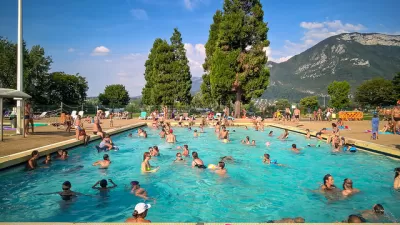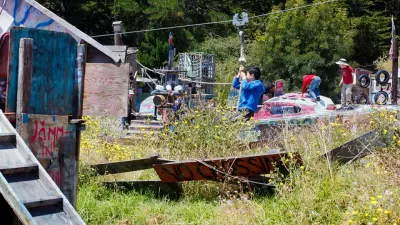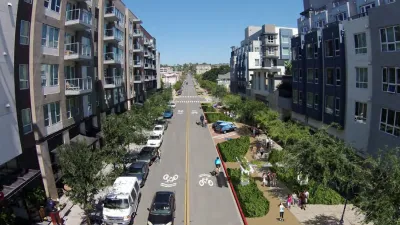As more and more children are kept in homes and yards, Joe Cortright worries about the effects of private play on American culture and public spaces.

"Changes in technology, the economy and society have all coalesced to create more fragmentation and division," Joe Cortright writes in City Observatory. This separation also affects children, Cortright argues, "instead of going to public parks and playgrounds, more children play in the copious backyards of suburban homes. This trend is amplified by helicopter parents."
As evidence of this growing separation, Cortright points to pools. In the first part of the 20th century, private pools were almost unheard of, now there are over 5 million. "The number of persons who belong to private gyms has increased from about 13 million in 1981 to more than 50 million," Cortright points out.
He goes on to say, "Public parks are one of the places where people of different races, ethnicities and incomes can come together and share experiences." As more people look to entertain themselves in private, these spaces may lose something important.
FULL STORY: New York Is Blowing The Kosciuszko Bridge Straight To Hell

Study: Maui’s Plan to Convert Vacation Rentals to Long-Term Housing Could Cause Nearly $1 Billion Economic Loss
The plan would reduce visitor accommodation by 25,% resulting in 1,900 jobs lost.

North Texas Transit Leaders Tout Benefits of TOD for Growing Region
At a summit focused on transit-oriented development, policymakers discussed how North Texas’ expanded light rail system can serve as a tool for economic growth.

Using Old Oil and Gas Wells for Green Energy Storage
Penn State researchers have found that repurposing abandoned oil and gas wells for geothermal-assisted compressed-air energy storage can boost efficiency, reduce environmental risks, and support clean energy and job transitions.

How Madison’s Tree Planting Efforts Are Growing a Healthier Community
Madison’s annual tree planting initiative is enhancing environmental resilience, public health, and community livability by adding 1,400 carefully selected trees citywide, with strong community and institutional support for urban forestry.

Texas State Bills Could Kill Transit Funding in Dallas, Austin
State lawmakers could pull funding from the state’s largest transit agency and the ambitious Project Connect, a voter-approved transit project in Austin.

Opinion: DC Encampment Sweeps Hide, but Don’t Solve, Homelessness
President Trump recently ordered the clearing of encampments built by unhoused people on federal land in Washington, D.C.
Urban Design for Planners 1: Software Tools
This six-course series explores essential urban design concepts using open source software and equips planners with the tools they need to participate fully in the urban design process.
Planning for Universal Design
Learn the tools for implementing Universal Design in planning regulations.
Ascent Environmental
Borough of Carlisle
Institute for Housing and Urban Development Studies (IHS)
City of Grandview
Harvard GSD Executive Education
Toledo-Lucas County Plan Commissions
Salt Lake City
NYU Wagner Graduate School of Public Service




























